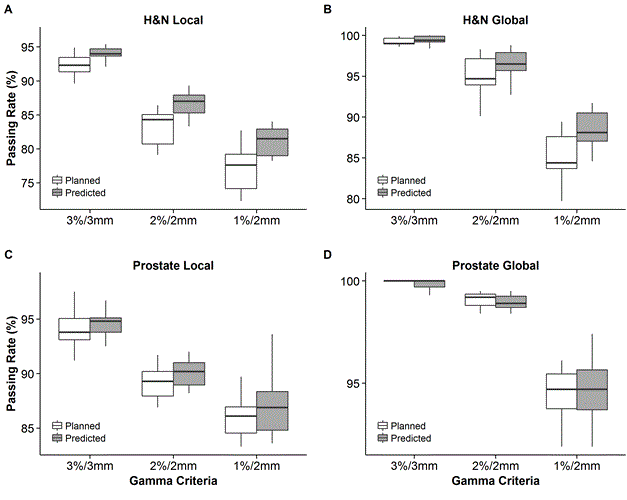글로벌 연구동향
의학물리학
- 2016년 04월호
[Phys Med Biol.] A machine learning approach to the accurate prediction of multi-leaf collimator positional errors.서울대/Joel N K Carlson, 예성준*
- 출처
- Phys Med Biol.
- 등재일
- 2016 Mar 21
- 저널이슈번호
- 61(6):2514-31
- 내용

AbstractDiscrepancies between planned and delivered movements of multi-leaf collimators (MLCs) are an important source of errors in dose distributions during radiotherapy. In this work we used machine learning techniques to train models to predict these discrepancies, assessed the accuracy of the model predictions, and examined the impact these errors have on quality assurance (QA) procedures and dosimetry. Predictive leaf motion parameters for the models were calculated from the plan files, such as leaf position and velocity, whether the leaf was moving towards or away from the isocenter of the MLC, and many others. Differences in positions between synchronized DICOM-RT planning files and DynaLog files reported during QA delivery were used as a target response for training of the models. The final model is capable of predicting MLC positions during delivery to a high degree of accuracy. For moving MLC leaves, predicted positions were shown to be significantly closer to delivered positions than were planned positions. By incorporating predicted positions into dose calculations in the TPS, increases were shown in gamma passing rates against measured dose distributions recorded during QA delivery. For instance, head and neck plans with 1%/2 mm gamma criteria had an average increase in passing rate of 4.17% (SD = 1.54%). This indicates that the inclusion of predictions during dose calculation leads to a more realistic representation of plan delivery. To assess impact on the patient, dose volumetric histograms (DVH) using delivered positions were calculated for comparison with planned and predicted DVHs. In all cases, predicted dose volumetric parameters were in closer agreement to the delivered parameters than were the planned parameters, particularly for organs at risk on the periphery of the treatment area. By incorporating the predicted positions into the TPS, the treatment planner is given a more realistic view of the dose distribution as it will truly be delivered to the patient.
Author information
Carlson JN1, Park JM, Park SY, Park JI, Choi Y, Ye SJ.
1Program in Biomedical Radiation Sciences, Department of Transdisciplinary Studies, Graduate School of Convergence Science and Technology, Seoul National University, Seoul 08826, Korea. Biomedical Research Institute, Seoul National University Hospital, Seoul 03080, Korea.
- 연구소개
- 다엽콜리메이터를 이용한 세기변조방사선치료 시 실제 치료계획대로 정확히 선량이 분포가 전달되지 않기 때문에 매 환자에 대해서 선량정도관리를 실시한다. 최신 기계학습법을 이용하여 치료계획대로 전달되지 못하는 다엽콜리메이터의 위치오차를 예측하여 전달 가능한 새로운 치료계획을 생성하여 실제 측정에 의한 방사선량 분포와 일치할 수 있음을 확인하였다. 이는 기계학습법을 이용하여 매 환자에 대한 소모적 선량정도관리를 대체할 수 있는 가능성을 처음으로 보여주었다.
- 덧글달기







